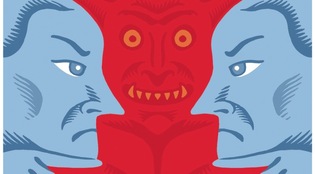 loading
loading
FindingsSpellbound Gregory NemecView full imageIn the early 1970s, while doing research in Harvard's Widener Library on the Salem witch hunts, John Demos realized that his connection to the subject wasn't just intellectual. He had run across one of many references to the role of the Putnam family when he abruptly became conscious of his own middle name: Putnam. "I literally jumped up from my seat and looked for a Putnam genealogy, and I traced the line right through," says Demos, now the Samuel Knight Professor of History at Yale. He discovered himself to be a direct descendant of John Putnam Sr., progenitor of the witch-hunting Massachusetts Putnams. "It took me all of ten minutes. It made the hair stand up on the back of my neck." Demos does not believe in karma, however. Or in witchcraft. In his latest book, The Enemy Within: 2,000 Years of Witch-hunting in the Western World, Demos uses insights from history, anthropology, and psychoanalysis to trace the common themes that, he says, characterize witch hunts. "The enemy within" is a double entendre, deftly summarizing Demos's two main theses. First, witch-hunters accuse people within their own communities. That inward-looking impulse distinguishes witch-hunting from discrimination, which marginalizes the "other": the Jew, the black, the Muslim. Second, Demos argues, the witch-hunting impulse comes from within the human psyche. When people dislike others, they may attribute their own malevolence to those they resent, rather than confronting their own troubling feelings. Similarly, people who feel guilty after denying help to neighbors in need may vilify those they rebuffed rather than acknowledging regret. Historians call it "the refusal-guilt syndrome." "That's the one fundamental point about witchcraft," says Demos, who won the prestigious Bancroft Prize in 1983 for Entertaining Satan: Witchcraft and the Culture of Early New England. "It involves a basic projection -- that's the clinical term -- from the enemy within to the supposed enemy without. Even though the details are enormously different from one historical or cultural setting to another, that's the dynamic. That's where the energy comes from." The Enemy Within begins not in Puritan New England but in second-century Gaul, where Roman magistrates accused early Christians of feasting on infants. It examines the "witch craze" from 1580 to 1650, when Europeans executed 100,000 fellow citizens. It describes Salem during 1692-1693; delineates the similarities between witch-hunting and both the 1919 Red Scare and the McCarthy-era black-listings; and deconstructs the U.S. day-care sex-abuse scandals that began in the 1980s, including the infamous McMartin preschool case in California. The McMartin trial lasted three years, with no convictions. Demos expects witch hunts to recur, catalyzed by people who see the world as "bipolar." "It's good and evil, it's black and white, it's either you're with us or you're against us. And there's some cosmic threat at the bottom of things." Resisting early is crucial. "A defining attribute of witch-hunting is the way the momentum builds. It's very hard to stop beyond a certain point -- because beyond a certain point, if you say 'Stop!' they'll call you a witch."
The comment period has expired.
|
|